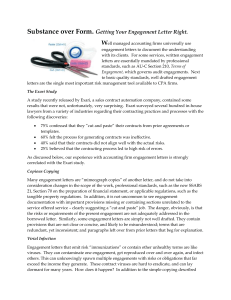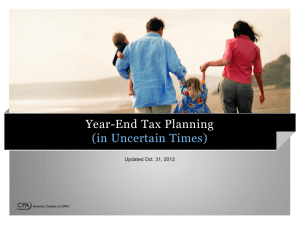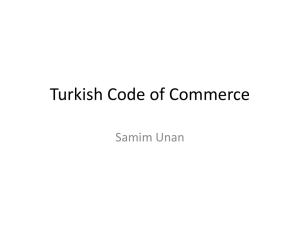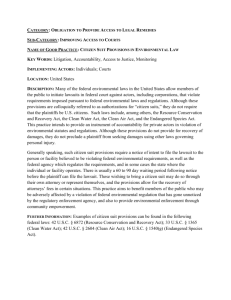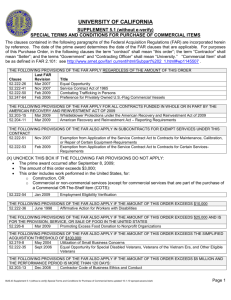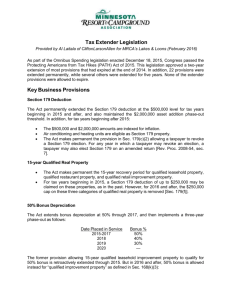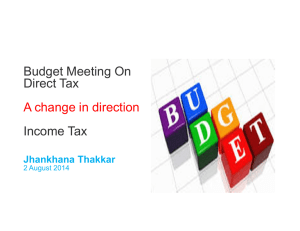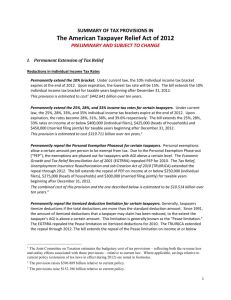3310 - Colorado State University
advertisement
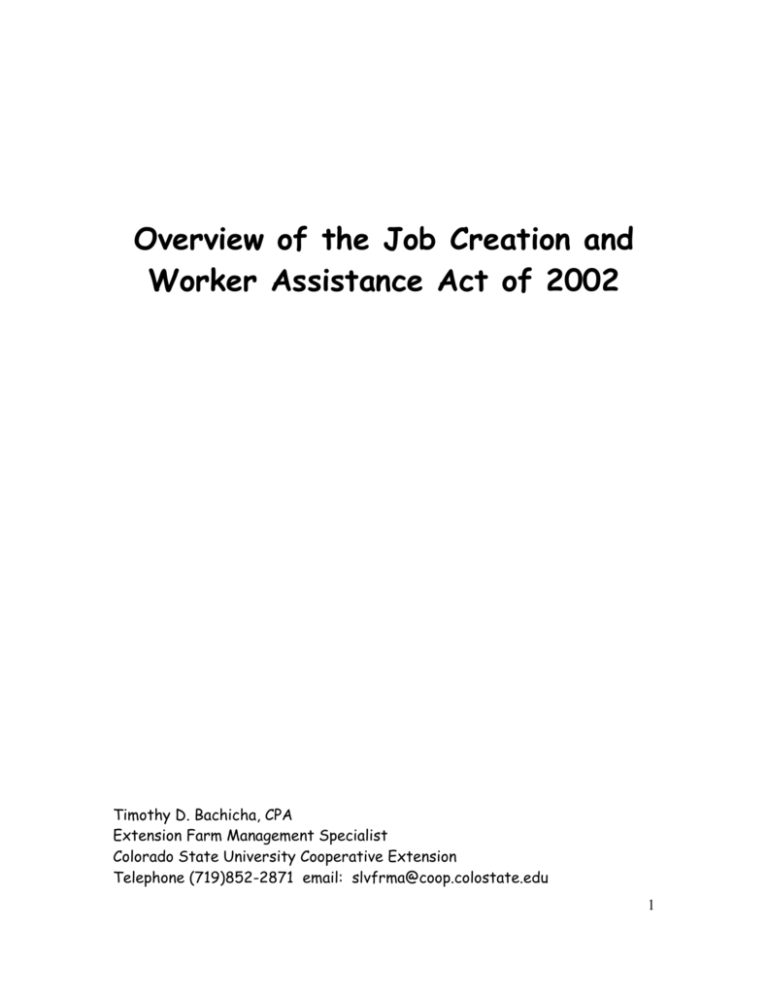
Overview of the Job Creation and Worker Assistance Act of 2002 Timothy D. Bachicha, CPA Extension Farm Management Specialist Colorado State University Cooperative Extension Telephone (719)852-2871 email: slvfrma@coop.colostate.edu 1 There are several provisions of the "Job Creation and Worker Assistance Act of 2002," (JCWAA 2002) signed by President Bush on March 9, 2002, that may affect your tax plans, and you may want to file an amended return for 2001. The new law includes: Provisions affecting unemployment compensation and the Temporary Assistance for Needy Families (TANF) Grant program. Temporary rules aimed at stimulating new business investment or providing tax relief for struggling businesses, Extensions of several expired or expiring tax provisions, and A set of temporary rules intended to facilitate recovery in the area of New York City devastated by the September 11, 2001, terrorist attack. The new law also contains technical corrections to previously enacted tax legislation, such as last year's "Economic Growth and Tax Relief Reconciliation Act of 2001," (EGTRRA) plus some miscellaneous items, including a temporary new rule that gives teachers a modest tax break for their out-of-pocket costs of classroom materials. 2 Broadest Impact Business Focused Tax Provisions The first of these allows a 30% first-year depreciation bonus on certain property acquired after September 10, 2001, and before September 11, 2004. The principal types of qualifying property are: Computer software, Assets having a depreciation period of 20 years or less, Water utility property, and Leasehold improvements made in business (i.e., nonresidential) premises. In order to qualify, the property must be placed in service before January 1, 2005, except that certain constructed property can qualify if placed in service before January 1, 2006. The other broadly applicable provision will allow businesses that suffer net operating losses ("NOLs") in 2001 or 2002 to apply those losses against taxable income as far back as five tax years instead of the general two-year "carryback" period. Thus, for example, if a firm was profitable before 2001, but suffered an operating loss that year, the loss could be used to reduce its taxable income—and thus generate tax refunds—for tax years as far back as 1996. For both these provisions you may want to amend 2001 returns if already filed. The 30% additional depreciation deduction is “mandatory” unless an election is made to not take it. This could mean that the IRS may require a reduction in adjusted basis of those eligible assets, even if you do not take the deduction! Analysis of your 2001 returns may also indicate a reason to amend on account of the NOL provisions. However, farmers already had the 5-year carryback available to them as a result of prior legislation. 3 Among its other business-related provisions, the new law: • Extends both the Work Opportunity Tax Credit and the Welfare-to-Work Tax Credit for two years (through December 31, 2003). • Extends the availability of the tax credit for the production of electricity from qualified wind energy, "closed-loop" biomass, or poultry waste to facilities placed in service before January 1, 2004. • Provides technical clarifications to several pension-related provisions contained in last year's economic stimulus legislation. • Defers the phase down of the deduction for Qualified Clean-Fuel Vehicle Property such that the full deduction will be available for qualified vehicles placed in service in 2002 and 2003 and a reduced deduction will be available for qualified vehicles placed in service in 2004, 2005, and 2006. • Extends the availability of the Qualified Clean-Fuel Vehicle Refueling Property deduction to property placed in service before January 1, 2007. • Extends, through taxable years beginning in 2003, the period during which the 100%-of-net-income limit for percentage depletion is suspended for oil and gas produced from marginal properties. • Extends, with modifications, the exceptions under Subpart F (concerning controlled foreign corporations, or "CFCs") for active financing income through December 31, 2006. • Prohibits certain discharge-of-indebtedness income from increasing an S corporation shareholder's basis in the S corporation's stock. (This provision prospectively overturns a Supreme Court decision.) • Restricts the use of the non-accrual experience method of accounting to specified services and services provided by certain small businesses (generally, businesses with average annual gross receipts of $5 million or less). • Temporarily increases the interest rate assumptions for determining required additional contributions and PBGC premiums for single-employer defined benefit pension plans. New York Liberty Zone Several provisions specifically target the "New York Liberty Zone," i.e., the area of Manhattan damaged by the September 11, 2001, attack. 4 Provisions Affecting Individuals The new law also contains several provisions affecting individuals personally or in their capacity as employees. Perhaps the most welcome of these is the extension of individual alternative minimum tax ("AMT") relief. This rule allows individuals to use their nonrefundable personal credits in full against their potential AMT liability in tax years 2002 and 2003. Compare this to the EGTRRA of 2001. Another temporary rule provides an incentive for educators to retain receipts of their out-of-pocket classroom expenses in 2002 and 2003. The rule permits an "above-the-line" deduction (i.e., not subject to the 2% limitation on miscellaneous itemized deductions) of up to $250 for books, supplies, equipment, and related items purchased for classroom use. The rule applies to kindergarten-through-grade-12 teachers, instructors, counselors, principals, or aides in a school for at least 900 hours during a school year. The new law extends the Archer Medical Savings Account ("MSA") program through December 31, 2003. The provision is intended to benefit individuals covered only by high-premium health plans. It permits, within certain limits, a deduction for amounts set aside by or for eligible individuals, the tax-free build-up of the fund, and tax-free distributions of amounts used for medical purposes. Among other changes, the new law also: • Extends the 10% credit for the cost of a qualified electric vehicle. The maximum credit available for purchases made in 2002 and 2003 is $4,000. • Broadens the category of payments that foster care providers may exclude from income. • Provides technical clarifications to the rules governing the adoption credit, education IRAs (now known as "Coverdell Education Savings Accounts"), and the dependent care credit. The purpose here was to alert you to some of the more significant provisions of the new law. The information presented herein is deemed accurate at the time it was prepared, however Colorado State University Cooperative Extension assumes no liability for how it is used. Individuals are encouraged to seek the assistance of qualified professionals in determining how these topics will affect them before making any decisions. 5

